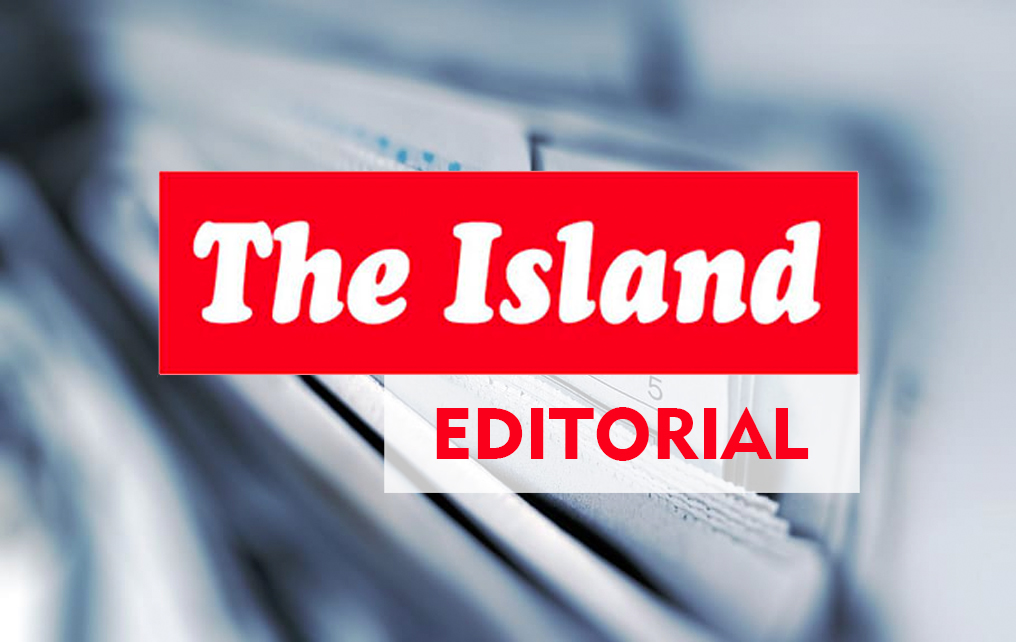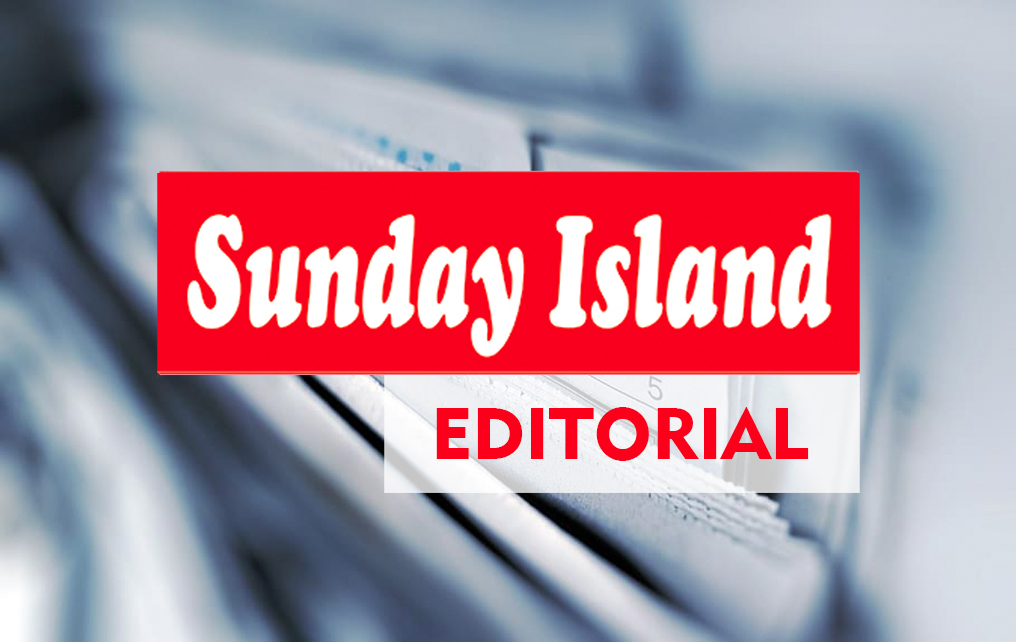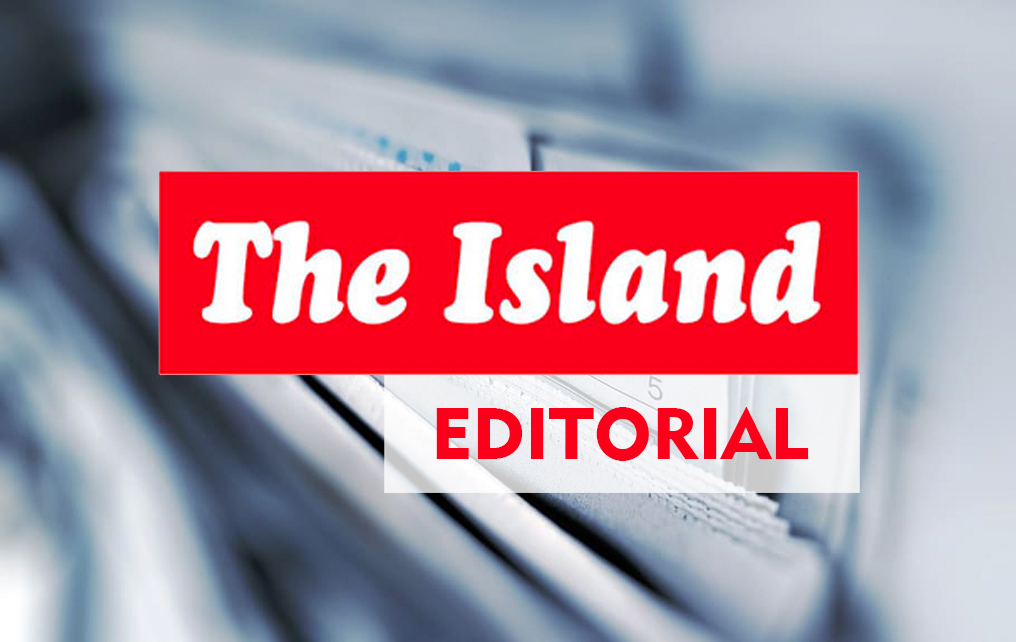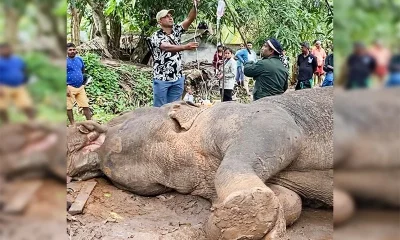Editorial
Replay of history?

Friday 23rd December, 2022
It looks as if we were witnessing a replay of what played out during the UNP-led UNF government between 2001 and 2004, a notable exception being that UNP leader Ranil Wickremesinghe has secured the executive presidency, and the Rajapaksas, who wrap themselves in the flag, have chosen to play second fiddle to him and support the UNP’s economic agenda, which they once rejected.
The UNF administration (2001-2004) stood accused of trying to ‘regain Sri Lanka’ by selling vital state assets. What is happening on the economic front at present reminds us of the UNP’s ‘Regaining Sri Lanka’ programme, which led to the divestiture of some valuable assets such as Sri Lanka Insurance Corporation and the bunkering facility at the Colombo Port, in the early noughties.
Mahinda Rajapaksa vowed to undo what the UNF regime had done under the Regaining Sri Lanka programme and made that one of the main planks of his 2005 presidential election campaign. He obtained a popular mandate to carry out his promise among other things. In fact, on his watch, the status quo ante was restored anent Sri Lankan Insurance and the port bunkering facility, thanks to a judicial intervention based on a COPE (Committee on Public Enterprises) report on those questionable deals. Today, the Rajapaksas are supporting the ongoing privatisation programme to the hilt, and Sri Lanka Insurance, and a section of the Colombo Port land that could be used for setting up a bunkering facility are among the assets up for sale!
Erik Solheim has come back. What’s up his sleeve, this time around, is anyone’s guess. He had himself appointed Norway’s special peace envoy here, but sullied his reputation by being partial to the LTTE. At the height of the war, in 2009, President Mahinda Rajapaksa almost threw him out of Temple Trees for claiming that Prabhakaran could not be defeated. Besides functioning as President Ranil Wickremesinghe’s International Climate Advisor, Solheim has reportedly undertaken to promote investment for Sri Lanka! One can only hope that he is not trying to bring in another Trojan horse all the way from Oslo.
Curiously, the Rajapaksas have not protested against Solheim’s appointment or his involvement in investment promotion. Perhaps, they have taken a liking to him or even consider him one of them because of some serious allegations against him. He had to quit as the head of the United Nations Environment Programme, in 2018, following an investigation the UN auditors conducted into the use of public funds by his agency. He was accused of overspending, among other things. No wonder he is in the good books of Sri Lankan leaders who are notorious for squandering public funds!
If Prabhakaran knew the situation in Sri Lanka, he would rue the day he closed the Mavil Aru sluice gates, resuming war, which caused him to meet his Waterloo in the Nandikadal lagoon, in 2009. Had he desisted from violating the Norwegian-crafted ceasefire, which was beneficial to the LTTE, and exercised patience, perhaps, he would have been able to achieve his goal without firing a single shot. A bankrupt country cannot fight a war, can it?
In 1994, President Chandrika Kumaratunga offered Prabhakaran the entire Northern Province for ten years without elections, provided he eschewed violence. A wag says that if he had been around, the current administration would have offered him both North and East in a bid to earn forex. After all, it is seeking the assistance of LTTE sympathisers to shore up the country’s foreign currency reserves!
Karl Marx has said history repeats itself first as tragedy and then as farce. In this country, it seems to be repeating itself as a black comedy, and dark humour found therein is reminiscent of the motif in Joseph Heller’s Catch -22, which is quite relevant to the present Sri Lankan context.
Editorial
Misplaced priorities

Sri Lanka has a very ‘promising’ government and a perennially protesting Opposition. The government makes various promises, which are like piecrusts made to be broken. The Opposition in a perpetual state of agitation bursts into protests at the drop of a hat. The two sides have been clashing in Parliament instead of sinking their political differences and cooperating at least in the aftermath of a disaster.
The Opposition has requested Speaker Dr. Jagath Wickramaratne to appoint a Parliamentary Select Committee (PSC) to probe the government’s alleged failure to mitigate the impact of Cyclone Ditwah despite repeated warnings issued by the Meteorology Department and the Irrigation Department. The government is determined to avoid a fate similar to that which befell the Yahapalana government following the Easter Sunday terror attacks, which became the undoing of that dysfunctional regime. It is therefore very unlikely to meet the Opposition’s demand at issue. Even if it agrees to appoint a PSC to probe its own alleged lapses, by any chance, it will not allow an Opposition MP to chair the committee and will go all out to frustrate its rivals’ efforts to ruin its political future.
Interestingly, some of the key Opposition members are former Yahapalana MPs who sought to derail a PSC probe into the 2015 Treasury bond scam. They craftily appointed a member of the JVP, which was a Yahapalana partner in all but name, as the Chairman of that PSC, and incorporated a slew of footnotes into the committee report in a bid to dilute it.
In this country, PSCs rarely help get to the bottom of the issues they probe. The PSC on the Treasury bond scam went out of its way to clear the then Prime Minister Ranil Wickremesinghe’s name, and helped the UNP scapegoat former Central Bank Governor Arjuna Mahendran and throw him to the wolves. In 2012, Mahinda Rajapaksa government turned a PSC probe into a witch-hunt against then Chief Justice Dr. Shirani Bandaranayake, who was subsequently wrongfully impeached. The PSC that investigated the Easter Terror attacks (2019) gathered a lot of valuable information but its findings, conclusions and recommendations were tainted by a glaring political bias.
Going by the government’s determined bid to let its MP Asoka Ranwala off the hook, following a road accident, how ruthless the JVP-led NPP will be in warding off threats to its political survival is not difficult to imagine. The Opposition can go on shouting until it is blue in the face but it will not be able to have the government’s alleged failure to heed disaster warnings and save lives investigated properly as long as the JVP/NPP is in power.
What we are witnessing on the political front, especially in Parliament, is like a drunken brawl at a funeral. The government and the Opposition are fighting while the country is mourning those who perished in recent floods and landslides.
What the political parties represented in Parliament ought to do at this juncture is to get their priorities right. They must stop clashing and make a concerted effort to carry out post-disaster rebuilding operations and strengthening the economy. They must not lose sight of the rapid depreciation of the rupee, and the disconcerting forecasts of an economic slowdown. The much-advertised revenue bubble, created by an unprecedented increase in vehicle imports, is about to burst, and the possibility of the country having a rupee crisis to contend with again cannot be ruled out. Foreign reserve targets are far from achieved, and there is a pressing need to boost the forex inflow and ensure that the country will be able to honour its pledge to resume foreign debt repayment in 2028.
All political parties have done precious little for the disaster victims. They have been only visiting the welfare centres and distributing relief materials collected from the considerate public. They ought to engage in post-disaster rebuilding actively. Reconstruction is a labour-intensive task. The self-righteous political leaders should mobilise their community level organisation for post-disaster rebuilding. Sadly, they have not even helped clean flood-hit houses.
Editorial
Cops as whipping boys?

Saturday 20th December, 2025
Disciplinary action has reportedly been taken against several police officers for their alleged failure to conduct a proper investigation into a recent accident caused by NPP MP Asoka Ranwala in Sapugaskanda. This move, we believe, has the trappings of a diversionary tactic. The police would have incurred the wrath of the government if they had conducted a breathalyzer test on Ranwala and produced him before a Judicial Medical Officer immediately after the crash where an infant, his mother and grandmother were injured.
Ranwala was subjected to a blood alcohol test more than 12 hours after the accident, according to media reports. The police would not have dragged their feet of their own volition. They were obviously made to do what they did. The law applies equally only to ordinary people. Will the police top brass explain why no disciplinary action was taken against the police officers who unashamedly sided with a group of JVP members involved in grabbing an office of the Frontline Socialist Party (FSP) in Yakkala in September 2025. After turning a blind eye to that blatant transgression, the police provided security to the JVP members who were forcibly occupying the FSP office. Thankfully, a judicial intervention made them leave the place. The current rulers claim they have not placed themselves above the law, unlike their predecessors. A wag says they have placed the law below them instead!
Having made a mockery of its much-advertised commitment to upholding the rule of law by intervening to prevent Ranwala from undergoing an alcohol test immediately after the aforesaid accident, the government is making attempts at face-saving. Curiously, blood samples obtained from Ranwala have been sent to the Government Analyst for testing! The government seems to have a very low opinion of the intelligence of the public, who voted for it overwhelmingly, expecting a ‘system change’.
It is being argued in some quarters that the disciplinary inquiry against the police officers has been scripted, and the charges against them will be dropped when the issue fizzles out. This argument is not without some merit, but there is a possibility of the government going to the extent of trying to clear its name at the expense of the police officers concerned if push comes to shove.
Successive governments have scapegoated police personnel and other state employees to safeguard their interests, and the incumbent administration is no exception; it has already sought to shift the blame for its failure to mitigate the impact of Cyclone Ditwah to the Meteorological Department, which, it has claimed, did not warn it about the extreme weather events fairly in advance. Opposition Leader Sajith Premadasa told Parliament on Thursday that the government had muzzled some senior officials of the Meteorological Department.
Some leaders of the incumbent government are bound to face legal action for their commissions and omissions when they lose power, and the state officials pandering to their whims and fancies will have to do likewise.
The public officials who are at the beck and call of politicians and carry out illegal orders should realise that they run the risk of being left without anyone to turn to in case they have to face legal action for their transgressions. Their ruthlessly self-seeking political masters will not scruple to sacrifice them.
Editorial
Disaster relief mired in dirty politics

Friday 19th December, 2025
Opposition Leader Sajith Premadasa has accused the government of interfering with the ongoing disaster relief programmes. Speaking in Parliament, on Thursday, he produced what he described as documentary proof to support his claim that disaster victims were required to have their applications for compensation endorsed by the heads of the Prajashakthi committees controlled by the JVP apparatchiks. Several other Opposition MPs have levelled the same allegation against the government in Parliament.
Two trade unions representing the Grama Niladharis have complained of political interference with their work, and even threatened to pull out of the disaster relief programmes unless they are allowed to carry out their duties and functions, free from political pressure.
Sri Lanka United Grama Niladhari Association (SLUGNA) President Nandana Ranasinghe told the media on 08 December that JVP/NPP politicians and their supporters were meddling with the disaster relief programmes at all levels and even obstructing the Grama Niladharis (GNs). He claimed that the political authority had sent letters to the District and Divisional Secretaries, directing them to appoint JVP/NPP members to the state-run welfare centres. SLUGNA Secretary Jagath Chandralal said state officials had been directed to obtain approval from the government members of the Prajashakthi committees for carrying out relief work. A few days later, addressing the media, Convenor of the Sri Lanka Grama Niladhari Association Sumith Kodikara also made a number of similar allegations. He said the NPP politicians were arbitrarily helping their supporters obtain Rs. 25,000 each as compensation. He stressed that only the disaster victims had to be paid compensation, and never had disaster relief programmes been politicised in that manner. These allegations are shocking enough to warrant probes, as we said in a previous comment.
Initially, the government denied the involvement of its Prajashakthi members in the process of selecting disaster relief beneficiaries, but now it allows them to work alongside state officials openly. This is an instance of the arrogance of power, which became the undoing of several previous governments, especially the ones led by the UNP and the SLPP. Minister K. D. Lal Kantha has gone on record as claiming that the Prajashakthi functionaries too should have a say in relief provision!
Funds the government is distributing among disaster victims belong to the state, and therefore no political party must be allowed to influence or control their disbursement. One can argue that it is prima facie unlawful for anyone other than authorised public officials to get involved in the process of distributing state funds as disaster relief. The Opposition should find out whether there is any legal provision for the involvement of the Prajashakthi functionaries in relief distribution or whether they are committing a transgression.
The government is apparently labouring under the mistaken belief that it can use disaster relief to shore up its approval rating as well as electoral prospects in view of the next election––the Provincial Council polls which it is coming under increasing pressure to hold next year. Political interference with disaster relief only exasperates the public beyond measure. A large number of disaster victims have held protests in several areas, claiming that they have been overlooked.
The JVP/NPP, which came to power promising to depoliticise the state institutions and revitalise the public service, should be ashamed of having stooped so low as to politicise the process of providing disaster relief. Politicians have a sense of shame only when they are out of power.
If the JVP/NPP leaders are wise, they will learn from the predicament of the Rajapaksas, who had to pay a heavy price for testing the patience of the public. The latter had to head for the hills with angry people in close pursuit. Now that the people have successfully got rid of a bunch of failed rulers, they may take to the streets again if their patience runs out. The government would do well to follow the established procedures in carrying out disaster relief programmes, without subjugating them to its political agenda and undermining their integrity.
-

 Midweek Review4 days ago
Midweek Review4 days agoHow massive Akuregoda defence complex was built with proceeds from sale of Galle Face land to Shangri-La
-

 News3 days ago
News3 days agoPakistan hands over 200 tonnes of humanitarian aid to Lanka
-

 News3 days ago
News3 days agoPope fires broadside: ‘The Holy See won’t be a silent bystander to the grave disparities, injustices, and fundamental human rights violations’
-

 News4 days ago
News4 days agoBurnt elephant dies after delayed rescue; activists demand arrests
-

 Editorial4 days ago
Editorial4 days agoColombo Port facing strategic neglect
-

 News2 days ago
News2 days agoArmy engineers set up new Nayaru emergency bridge
-

 Business2 days ago
Business2 days agoUnlocking Sri Lanka’s hidden wealth: A $2 billion mineral opportunity awaits
-

 News4 days ago
News4 days agoSri Lanka, Romania discuss illegal recruitment, etc.













